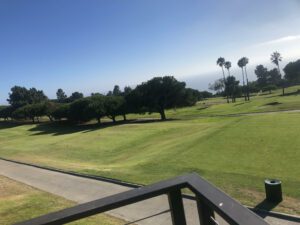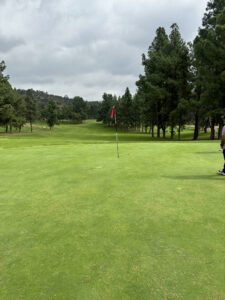Golf courses are noted for their meticulously maintained greens and fairways, and Bermuda Grass plays a significant role in shaping their appearance. With its heat tolerance, rapid growth, and firm surface, it’s no wonder that Bermuda Grass has become a staple for many courses worldwide.
This article explores its history, characteristics, comparisons with other popular golf grasses, and environmental impacts, including the potential for methane emissions from soil management practices used in its cultivation. Understanding how methane emissions can influence the environment is essential for developing sustainable golf course management strategies.
The History and Evolution of Bermuda Grass in Golf
Origin and Spread of Bermuda Grass

Native to Africa, Bermuda Grass quickly gained popularity for its adaptability to warm climates and tough conditions. The grass spread to North America and became especially prominent in the southern United States due to its ability to endure the region’s intense heat and arid conditions. Its strong root system and capacity for rapid growth made it an appealing choice for landscapers and golf course managers.
Bermuda Grass and Its Historical Role in Golf Course Design
Bermuda Grass became synonymous with golf courses over time because of its durability, resilience, and ability to form a dense playing surface. The demand for specialized turf saw the development of hybrids tailored to meet the high standards of golf. Today, Bermuda Grass continues to be a primary feature on tees, fairways, and putting greens, proving its worth in various climates.
Characteristics of Bermuda Grass
Adaptability to Warm Climates
Bermuda Grass thrives in hot, sunny environments, particularly in the southern U.S. Its deep root system allows it to access water in dry conditions, ensuring a green, lush appearance even during heatwaves. This adaptability makes it ideal for regions that experience prolonged periods of warm weather.
Resilience to High Traffic and Damage
Its dense growth and tough stolons mean Bermuda Grass can fondle the heavy foot traffic that golf courses endure daily. Whether it’s the constant motion of golfers or the impact of maintenance equipment, Bermuda Grass quickly recovers from wear.
Rapid Recovery and Dense Growth
Bermuda Grass has a stoloniferous growth pattern that helps it spread quickly, filling bare patches and maintaining a smooth, even playing surface. Its rapid recovery rate ensures the course remains playable throughout the year, even in high-traffic areas.
Types of Bermuda Grass and Their Specific Uses
Hybrid Varieties for Putting Greens
Hybrids like Tifway and Tifdwarf are bred specifically for golf course use, providing a dense, smooth surface required for putting greens. They require more meticulous maintenance, including frequent mowing and irrigation, to sustain their high-quality appearance and performance.
Common Bermuda for Fairways and Roughs
Common Bermuda Grass remains a popular choice for fairways and roughs because it can withstand heavy traffic while providing a consistent surface that is easy to manage. Its ability to handle extreme heat and regrow quickly ensures it remains reliable for high-use areas.
Comparing Bermuda Grass to Other Popular Golf Grasses
Bentgrass
Bentgrass, primarily a cool-season grass, is well-suited for northern climates. It requires consistent watering and frequent mowing due to its delicate structure, providing a soft, smooth putting surface often preferred for greens. However, it is more susceptible to disease, particularly in hot or humid conditions. Bermuda Grass, in contrast, thrives in warmer climates with greater drought tolerance. It also has faster recovery from high traffic, making it better suited for fairways and tees in warm regions.
Zoysia
Zoysia is a warm-season grass like Bermuda but has greater shade tolerance, making it an option for shaded courses. It’s more resistant to disease than Bentgrass but does not handle drought, as well as Bermuda Grass. Zoysia requires less frequent mowing but benefits from consistent fertilization to maintain its thick and lush appearance. Bermuda Grass, on the other hand, has a firmer, faster surface and quicker recovery, making it a preferred choice in regions where it’s sunny and dry.
Kentucky Bluegrass
Kentucky Bluegrass is a cool-season grass famous in temperate climates due to its lush appearance and adaptability. However, it is prone to diseases like leaf spot and requires consistent irrigation and fertilization. Bermuda Grass thrives in high temperatures, offering resilience against pests and diseases. Its rapid growth provides a firm surface that supports faster play. Kentucky Bluegrass tends to be used more on fairways and roughs, while Bermuda Grass is commonly selected for all areas of the course due to its versatility and resistance to heat.
Environmental Benefits and Drawbacks of Bermuda Grass
Bermuda Grass provides many environmental benefits that make it an attractive choice for golf courses, particularly those in warmer climates. These advantages help create lush and resilient greens and fairways with minimal environmental impact.
 Benefits
Benefits
Bermuda Grass boasts several benefits that make it a top contender for golf courses. Its adaptability to challenging conditions and resistance to pests ensure that golf courses remain healthy and visually appealing.
- Heat and Drought Tolerance: Bermuda Grass can withstand high temperatures and drought, requiring less frequent watering. Its deep root system enables it to remain green and healthy even in scorching conditions.
- Pest and Disease Resistance: Its robust growth and natural resistance mean that it needs fewer chemical treatments, making it an eco-friendly choice.
- Salt Tolerance: Bermuda Grass can tolerate salt levels in coastal regions, making it suitable for courses near the ocean.
- Rapid Recovery from Wear: The grass recovers quickly from damage due to its rapid growth pattern, making it ideal for areas with high foot traffic.
- Soil Stabilization: Its dense root system prevents soil erosion, maintaining soil integrity even in adverse conditions.
Drawbacks
Despite the numerous advantages, Bermuda Grass also has drawbacks that require careful management. These challenges can affect playability and course maintenance if not properly addressed.
- Dormancy in Cooler Seasons: In cooler weather, bermuda goes dormant and turns brown, impacting its visual appeal. This dormancy period can influence the overall appearance of the golf course.
- Over-Watering Issues: Over-watering can lead to disease, requiring careful irrigation management to prevent conditions like root rot and fungus.
- Invasive Growth Potential: Bermuda can aggressively spread into unwanted areas, necessitating vigilant containment practices to prevent it from becoming invasive.
- Thatch Build-Up: The rapid growth of Bermuda can lead to thatch accumulation, requiring consistent aeration to prevent nutrient absorption issues.
- Maintenance Requirements: Maintaining Bermuda requires regular mowing and fertilization to keep it healthy and playable, which can be time-consuming.
- Potential for Methane Emissions: In some cases, the organic matter in the soil under Bermuda, especially in poorly aerated or waterlogged areas, might decompose anaerobically, producing methane. This greenhouse gas can contribute to environmental issues if not properly managed, underscoring the need for effective soil health monitoring and methane mitigation strategies on golf courses.
Maintaining Bermuda Grass on Golf Courses
Irrigation Strategies
Bermuda Grass thrives on deep but infrequent watering. Monitoring soil moisture levels ensures the proper amount of water reaches the grass for optimal root development. Deep watering encourages strong, drought-resistant roots while preventing over-irrigation and disease issues.
Proper Mowing Heights
Maintaining consistent mowing heights across greens, tees, and fairways is crucial. Greens need the lowest mowing height for smooth putting surfaces, while tees and fairways benefit from a slightly higher cut for consistent playability. Regular mowing prevents scalping and thatch buildup, promoting a dense and even turf.
Soil Aeration and Nutrient Management
Aerating the soil prevents compaction and improves nutrient absorption, while fertilization provides essential nutrients. Soil testing identifies deficiencies, allowing for balanced nutrient applications that prevent excessive growth and vulnerability to disease.
Pest and Weed Control
Pests like grubs and armyworms can damage this grass type if left unchecked, so regular inspections and prompt treatments are essential. Weed control reduces competition for nutrients and sunlight. Pre-emergent herbicides block weed seeds from germinating, while post-emergent treatments target existing weeds.
Methane and Vapor Mitigation Needs
When golf courses are located near landfills or old oil drilling sites, methane mitigation systems are essential to safely ventilate or burn off methane gas, reducing health and safety risks. In areas with industrial soil contamination, vapor mitigation systems prevent toxic vapors from entering buildings, ensuring the safety of visitors and employees. Proper implementation of these systems can significantly reduce health hazards and maintain an optimal playing environment.
Innovations in Bermuda Grass Breeding and Management
Genetic Improvements for Disease Resistance
Recent hybrid varieties have been developed with enhanced disease resistance, helping the grass withstand common issues like dollar spots and brown patches. These genetic improvements ensure a lush, green, and durable playing surface.
Water-Efficient Irrigation Technology
Modern irrigation systems use advanced moisture sensors and soil monitoring to deliver water precisely. These systems provide efficient watering directly to the roots, preventing over-watering and reducing waste.
Remote Monitoring and Automated Maintenance
Remote monitoring lets golf course managers oversee irrigation and soil conditions in real-time, identifying issues early. Automated maintenance equipment like robotic mowers ensures consistent mowing schedules, creating a uniform, well-maintained turf.
Conclusion: Making the Right Choice for Your Golf Course
Selecting the right grass type requires understanding the course’s climate, soil, and maintenance needs. Bermuda Grass offers outstanding adaptability, resilience, and playability for warm-climate courses. Managers can balance aesthetics and functionality by carefully considering each grass type’s strengths and weaknesses.
Additionally, for courses situated near potential methane sources like landfills or reclaimed industrial sites, incorporating methane mitigation design into the construction and ongoing maintenance can be crucial. This ensures that environmental safety and sustainability are maintained alongside aesthetic and functional considerations.
Bermuda Grass remains an efficient, sustainable solution that meets the high standards of golfers and course owners, further enhanced by responsible environmental management practices.
